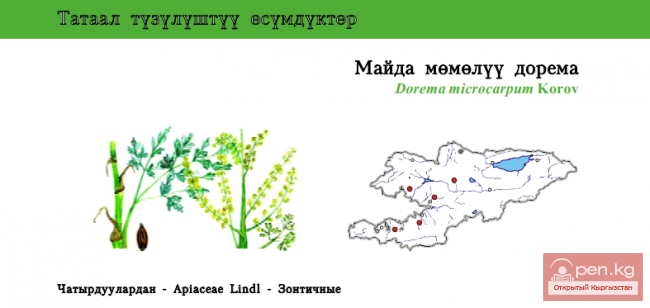
False Hooked Fumitory Status: VU. Endemic species of the Pamir-Alai....

Cnidiocarpa alaica Status: VU. A rare representative of a monotypic genus....

Incarvillea olgae Status: CR B2ab(iii). A very rare, critically endangered ancient species...

Paradoxical Honeysuckle Status: Category CR B2ab(iii). A relict endemic species with a disjunctive...

Edelweiss-like Pyrethrum Status: VU. Endemic species....

Vvedensky’s Sage Status: VU. A very rare narrowly endemic species. An ornamental plant....

Alai Centaury Status: VU. Endemic species....

Glacial Pastinacopsis Status: EN. A rare endemic species of a monotypic genus in the Northern Tien...

Kosopoljanskaya Turkestanian Status: VU. One of the two endemic species of this genus found in...

Nathaliella alaica Status: CR B2ab(iii). A rare, endemic species of a monotypic genus of Himalayan...

Knorring’s Larkspur Status: VU. A rare ornamental relic species with a disjunctive range, endemic...

Sclerotiaria pentaceros Status: CR B2ab(iii). Endemic to a monotypic genus....

Eugenia's Primrose Status: VU. A narrow endemic rare, highly ornamental species. Found in...

Eugenia’s Bell-flower Status: VU. Endemic to the Western Tien Shan (Talas and Fergana Ranges). A...

html Lamyropappus schakaptaricus Status: VU. A rare representative of a monotypic genus....

Chesneya villosa Status: EN. One of the three very rarely encountered species of this genus in...

Tianschaniella umbellifera Status: VU. A significantly declining narrowly endemic species of...

Acantholimon compactum Status: VU. A very rare narrowly endemic species....

html Korshinsky’s Meadow Saxifrage Status: EN. A rare endemic species found in small numbers and...

Schennikov’s Otostegia Status: VU. A rare endemic species, endemic to Kyrgyzstan with a disjunct...

Anomalous Alajja (Erianthera anomala) Status: VU. Endemic to the mountains of Central Asia. A rare...

Aulie-Ata Stemmacantha Centaury Status: EN. A very rare species, critically endangered....

Galatea Tiger Beetle Status: Category I (EN B1ab(iv)+2ab(iii,iv)). A narrowly endemic species with...

Kostychev’s Pascueflower Status: VU. A narrowly endemic and very beautiful plant, deserving...

Hairy Flowering Plant Aulie-Ata Status: EN. A representative of a monotypic section, a narrowly...

Rhodiola litwinowii Status: LC. A mosaic-distributed species, intensively used in agriculture....

Large-calyxed Primrose Status: VU. In Kyrgyzstan, it is a very narrowly distributed, rare,...

Seaholly-like Meadow Saxifrage Status: VU. Endemic. One of 16 species found in Kyrgyzstan....

Peregrine Falcon Status: Category VII, Least Concern, LC. One of 10 species of the genus in the...

Broad-stamened Tulip Status: VU. A narrow endemic of the Alai Ridge....

Alai Bubblewort Status: VU. A rare narrowly endemic species....

Short-winged Bladder-senna Status: VU. One of three very rarely occurring species of this genus in...

Golden Trichanthemis Centaury Status: VU. A rare narrowly endemic species of the Alai Ridge, an...

Dorema microcarpum Status: VU. Rare endemic species....

Iskandera Alai Status: VU. A very rare narrow endemic species. There is only one species of this...

Kaufmannia Semenova Status: VU. Endemic, rare species....

Semenov’s Onion Status: VU. Endemic to the Inner Tien Shan....

Eduard’s Imperial Crown Status: EN B1ab(i,ii,iv,v). In Kyrgyzstan - the only one of three very...

Central Asian Tortoise Status: VU Blab (ii, iii, v); Cl. A representative of a monotypic genus,...

Sievers’s Apple-tree Status: LC category. A polymorphic species of the mountain-central Asian...

Wolly-fruited Kosopoljanskia Status: EN. Endemic. One of the two species that are sub-endemic to...

Regel’s Eminium Status: VU. A rare endemic species of the Western Tien Shan....

A specific form of natural conditions is represented by the internal adverse dangerous natural...